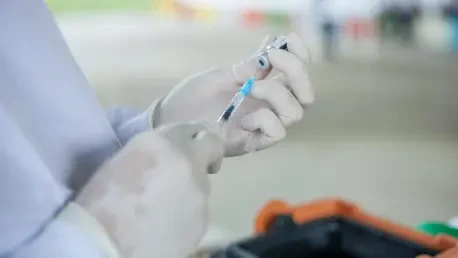Imagine a world where diseases once thought to be relics of the past—such as measles or polio—reemerge with devastating force, striking communities unprepared due to declining trust in one of modern medicine’s greatest achievements: vaccines. This alarming scenario is becoming a reality across the United States as vaccine hesitancy, fueled by misinformation and political divides, drives a resurgence of preventable illnesses. The decline in vaccination rates poses a significant threat to public health, unraveling decades of progress and endangering vulnerable populations. This summary delves into the root causes of this crisis, examines critical data and findings, and explores the urgent implications for society.
The Rising Threat of Vaccine Hesitancy
Vaccine hesitancy has emerged as a formidable barrier to maintaining public health, directly contributing to the return of diseases like measles that were once nearly eradicated in the U.S. This growing reluctance to vaccinate stems from a complex web of factors, including widespread misinformation that casts doubt on vaccine safety and efficacy. The phenomenon is not merely a personal choice but a public health crisis that undermines herd immunity, leaving entire communities at risk of outbreaks.
A significant challenge lies in the proliferation of “alternative facts,” often spread through social media and amplified by influential figures, which erode trust in scientific consensus. Public skepticism is further compounded by a lack of effective communication from health authorities, failing to counter false narratives with clear, accessible information. As a result, vaccination rates are declining, particularly among children, creating gaps in protection that pathogens exploit with alarming efficiency.
Key questions remain about why this hesitancy persists despite overwhelming evidence supporting vaccines. The impact on public health outcomes is stark, with increased hospitalizations and even deaths linked to preventable diseases. Addressing this issue requires understanding the social and psychological drivers behind the refusal to vaccinate, a task made urgent by the escalating consequences of inaction.
Historical Context and Societal Impact
Vaccines have historically been a triumph of medical science, virtually eliminating deadly diseases such as polio and controlling measles through widespread immunization programs. In the mid-20th century, these interventions saved countless lives, transforming public health landscapes and fostering collective trust in scientific advancements. Their success was a testament to the power of community cooperation in combating infectious threats.
However, societal perceptions have shifted dramatically over recent decades, moving from near-universal acceptance to growing skepticism. This change is driven by misinformation campaigns that falsely link vaccines to unproven risks, compounded by political polarization that frames vaccination as a matter of individual liberty rather than collective responsibility. Such narratives have gained traction, particularly in an era where personal anecdotes often outweigh scientific data in public discourse.
The relevance of this issue cannot be overstated, as declining vaccination rates threaten to reverse hard-won gains in disease prevention. Outbreaks of once-controlled illnesses carry life-threatening consequences, especially for unvaccinated children and immunocompromised individuals. The urgent need to address this public health crisis is evident, demanding strategies to rebuild trust and reinforce the importance of immunization as a societal safeguard.
Research Methodology, Findings, and Implications
Methodology
To understand the scope of vaccine hesitancy, a comprehensive analysis was conducted using data from public health reports, vaccination rate statistics, and studies examining the spread of misinformation. This approach included reviewing state-level immunization records for school-aged children and synthesizing findings from academic research on vaccine myths. Expert opinions from reputable institutions, such as Johns Hopkins University, provided critical insights into the social dynamics of hesitancy.
Data collection also focused on identifying patterns in public health communication failures, drawing from documented case studies of disease outbreaks linked to low vaccination rates. Sources encompassed a range of credible materials, including peer-reviewed journals and health policy analyses, ensuring a robust foundation for assessing the scale and drivers of this issue. The methodology prioritized objectivity, aiming to capture both statistical trends and qualitative perspectives on public attitudes.
Findings
The data reveals a troubling decline in vaccination rates, particularly among children entering kindergarten, with full immunization coverage dropping to just over 92% in the current school year. In certain states, such as Idaho, rates have fallen below 80%, far short of the threshold needed for herd immunity. This downturn correlates directly with a resurgence of measles, with over 1,300 cases documented recently across 40 states, accompanied by significant hospitalizations and fatalities among the unvaccinated.
Further analysis points to misinformation as a primary driver of hesitancy, often propagated through online platforms and reinforced by political rhetoric. High-profile figures have played a notable role in spreading doubt, leveraging their platforms to question vaccine safety despite lacking scientific credentials. Poor communication from health officials has exacerbated the problem, failing to effectively counter false claims with transparent, evidence-based messaging.
The findings also highlight a shift in public perception, where vaccination is increasingly viewed as a personal choice rather than a public health imperative. This trend, fueled by narratives of government overreach, has been particularly pronounced since the debates surrounding COVID-19 vaccines. The resulting vaccine refusal has led to tangible health crises, underscoring the urgent need for intervention to stem the tide of preventable diseases.
Implications
The immediate public health impact of vaccine hesitancy is evident in the return of eradicated diseases, placing significant strain on healthcare systems forced to manage preventable outbreaks. Hospitals report increased admissions for conditions like measles, diverting resources from other critical care needs. These outbreaks disproportionately affect vulnerable populations, amplifying existing health inequities.
Looking ahead, the long-term consequences could be catastrophic if trust in vaccines is not restored, potentially reversing decades of progress in disease prevention. The erosion of herd immunity threatens not just current generations but also future ones, as once-controlled pathogens regain footholds in communities. This scenario risks undermining global health initiatives that rely on high immunization coverage to prevent pandemics.
Addressing these challenges requires innovative communication strategies and robust policy frameworks to counter misinformation effectively. Public health campaigns must prioritize rebuilding confidence in immunization programs by engaging communities directly and addressing specific concerns. Without such efforts, the societal cost of hesitancy will continue to mount, necessitating urgent action to protect collective well-being.
Reflection and Future Directions
Reflection
Addressing vaccine hesitancy in an era marked by rampant misinformation and deep political division presents a multifaceted challenge. The complexity lies in navigating a landscape where scientific evidence often competes with emotionally charged narratives that resonate more strongly with skeptical populations. This dynamic complicates efforts to shift public opinion toward acceptance of vaccines as a public good.
Significant hurdles remain in reaching those who distrust health authorities, as current messaging often fails to connect with their values or address underlying fears. Public health strategies have sometimes overlooked the cultural and psychological factors that shape attitudes toward immunization. Recognizing these shortcomings highlights the need for tailored approaches that go beyond mere data dissemination.
Moreover, there is a clear gap in understanding the deeper social drivers behind hesitancy, such as the role of community norms or historical mistrust in medical systems. Further research into these areas could illuminate pathways for more effective interventions. Acknowledging these complexities is a critical step toward designing solutions that resonate with diverse audiences and rebuild faith in vaccination.
Future Directions
Research into communication methods that effectively counter misinformation stands as a priority for reversing vaccine hesitancy trends. Studies should explore how storytelling, peer influence, and digital platforms can be leveraged to present vaccine benefits in relatable ways. Developing messages that resonate emotionally while grounding them in science could prove instrumental in changing perceptions.
Policy interventions also warrant exploration, particularly those aimed at depoliticizing vaccination and reinforcing its role as a cornerstone of public health. Initiatives could include bipartisan health campaigns or incentives for immunization that avoid framing the issue as a political battleground. Such measures might help shift the narrative back to a focus on community protection over individual choice.
Additionally, examining the impact of emerging technologies and newer vaccines on public perception offers a promising avenue for study. Understanding how innovations like mRNA vaccines are received, and addressing concerns about their novelty, could shape future acceptance rates. These research directions are essential for crafting a comprehensive response to the evolving landscape of vaccine hesitancy.
A Call to Action
This exploration underscored the dangerous link between vaccine hesitancy, propelled by misinformation and political influence, and the alarming resurgence of preventable diseases like measles. The evidence painted a grim picture of declining vaccination rates and their direct consequences, from hospitalizations to loss of life. The critical role of vaccines as a bedrock of modern medicine was reaffirmed, highlighting their indispensable value in safeguarding public health.
Looking back, the urgency to combat false narratives through enhanced health communication emerged as a pivotal takeaway. Actionable steps forward included investing in community-driven education campaigns that address specific fears and misconceptions head-on. Collaborations between policymakers, scientists, and local leaders could help depoliticize the issue, fostering an environment where immunization is viewed as a shared responsibility.
Beyond immediate responses, sustained efforts to study and adapt to changing public attitudes were deemed essential. Innovations in how health messages are delivered, alongside policies that prioritize transparency, offered hope for reversing hesitancy trends. Protecting future generations from preventable illnesses demanded this collective commitment, ensuring that the lessons of past outbreaks guided a healthier tomorrow.









